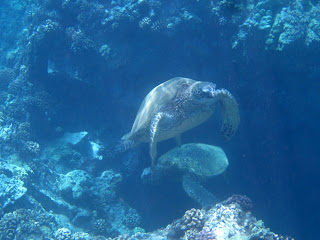on wednesday we took a day trip to molokai, one of main hawaiian islands. molokai is 38 miles by 10 miles and has a population of less than 8,000. despite its size, molokai is known as the friendly isle. we learned that everyone literally knows everyone and there is a true sense of family and community on the island. the island is pretty deserted (you can miss downtown if you blink too long) and has extensive natural beauty.

during the 19th century, sufferers of leprosy were forced into quarantine by the hawaiian government in a small north shore colony called kalawao (the original colony cannot be seen in this picture, but it was later moved to kalaupapa which is in the picture to the left). although the segregation policy was lifted in 1969, there are a small number of individuals with leprosy who still live on the colony today. it is not easy to get to the colony and they do not like visitors as many people do not know how to react to their condition.


molokai was fortunate to have father damien de veuster become a long term resident on the island during this time period. father damien, a belgian born priest, was cannonized for the treatment and care he provided to long term sufferers of leprosy. he also built many churches on the island, many of which still stand today. the impact father damien had on the people is obvious, given that there are over 25 registered churches as well as many other churches on the island. to the left, is a statue of father damien. on the right is a picture of one of the churches he built -- this is the only one that has not been modified or enlarged since it was originally built.


during our time on the island, we also went to a macadamia nut farm. i was surprised to learn that the trees has to grow for approximately 10 years before it begins to produce and then can produce for over 100 years. the trees continue to produce all year long and the nuts are retrieved daily once they fall to the ground. the nuts are then cracked (with a machine or hammer) and can be eaten directly. however, the macadamia nuts found in the grocery store are usually further refined by roasting and with the addition of preservatives. naturally found macadamia nuts only have a shelf life of about a month or so.
last random fact: molokai has the longest reef in the u.s. reaching approximately 25 miles.


















































